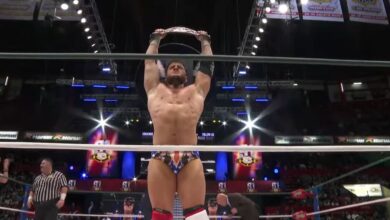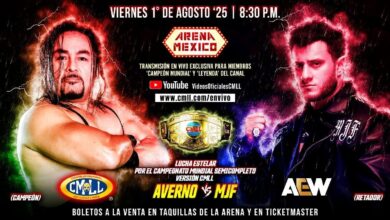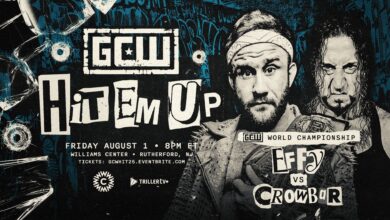Legacy under the Eggshell
On January 4, New Japan Pro Wrestling will hold its 45th event at the Tokyo Dome. The organization has been associated with the venue since its opening 30 years ago.
There is something majestic about athletes strutting down the long aisle of the Tokyo Dome. The Japanese crowd, notoriously respectful, sometimes incredibly quiet, has always been in awe of these larger-than-life figures when they walk by them or showcase their skills in the squared circle. What Madison Square Garden once meant to the World Wrestling Federation and T-Mobile Arena may one day mean to the Ultimate Fighting Championship is on par with the importance of the Tokyo Dome to New Japan Pro Wrestling.
Opening his doors in 1988, the arena, often called “The Big Egg” because of his air-supported, shell-like roof, quickly became the venue of all venues in the land of the rising sun. “It was the ultimate symbol for the hubristic bubble economy in the Japanese ‘80s,” Chris Charlton notes in his book “Lions Pride.” Before the construction of the Dome, the arenas which hosted historic events such as the famous Rikidōzan vs. Masahiko Kimura fight at Kuramae Kokugikan in 1954 or the encounter between Antonio Inoki and Muhammed Ali at Nippon Budokan in 1976 were considerably smaller and did not necessarily transport the magnitude of what Japanese audiences witnessed. But the specific atmosphere, which usually seemed far too aloof to the eyes of Western viewers who might have had the chance to travel to Japan and were used to the raving boxing and professional wrestling crowds of the 1970s and 1980s, did not get lost when the Tokyo Dome with a capacity beyond 50,000 established itself as the go-to venue superseding the much smaller Sumo Hall.
First There Were the Soviets
The times of success and misery New Japan experienced over the years have usually been closely tied with the Tokyo Dome. In 1988, Japanese pro wrestling was probably the hottest thing in the entire industry. Selling out such a large venue was soon not that big of a deal anymore, although many feared the promotions would overestimate their drawing power at first. But with New Japan as well as the short-lived Union of Wrestling Forces International running the Tokyo Dome successfully throughout the 1990s, those concerns were soon to be forgotten. “Today, the Tokyo Dome has held more successful events than any stadium of its size in the world,” Dave Meltzer recently wrote in an edition of his Wrestling Observer Newsletter.
The renowned expert for Japanese wrestling also pointed out how New Japan needed something big to jumpstart the Dome. The first event on April 24, 1989, featured the headlining fight between Antonio Inoki and Chota Chochishvili. Inoki, the long-time godfather of New Japan, successfully signed multiple combat athletes from the Soviet Union including Chochishvili, a Georgian judoka and gold medalist at the 1972 Summer Olympics in Munich. The gamble paid off, as 43,000 came to see Inoki losing the so-called world martial arts championship to Chochishvili.
From then on, New Japan had one Tokyo Dome sellout after another. The first January 4 event, which has since often been the climax of the year for NJPW, took place in 1992 when the card featured stars from World Championship Wrestling such as Sting and Lex Luger. Multi-million dollar gates generated by ticket sales meant the Dome became not only a mystical place but also a moneymaker for New Japan as well as the UWFI, notably in 1995 when the showdown between both promotions in a Tokyo Dome event attracted attention beyond the Japanese border.
The Dome mystique was further built up by the double-retirement year of 1998. Within four months, both Inoki and Riki Choshu said goodbye from in-ring action at separate events. Ticket sells did not significantly drop until the mid-2000s when lousy decision-making and a lack of household names started hurting New Japan. The Dome has always been a measuring stick, and up until 2002, the audience numbers were usually around 50,000 with repeated sellouts. Only a few years later, the promotion struggled to get above 20,000. A half-empty Dome illustrated how lifeless New Japan was at the time.
Popping Eyes and Dropping Mouthpieces
Some of the most memorable moments the arena has witnessed over the years did not even happen inside a pro wrestling ring. Most famously, Mike Tyson suffered his first loss as a pro boxer at the Tokyo Dome in what many historians consider the greatest upset in combat sports history. On February 11, 1990, the universally undisputed and widely feared heavyweight champion took on underdog Buster Douglas and lost via tenth-round knockout. While many fans on the other side of the Pacific Ocean did not believe that Douglas would pose any threat to Tyson, the pictures of a crawling “Iron Mike” who desperately reached for his mouthpiece after being knocked to the canvas went around the world.
The fight itself marked one of many devastating blows to Tyson’s career at the time. In the light of his abusive relationship with Robin Givens, the departure of longtime trainer Kevin Rooney, and disputes between longtime manager Bill Cayton and flamboyant promoter Don King, it still seemed impossible that Tyson could lose. The fight itself was nothing short of controversy, as referee Octavio Meyran might have conducted a slow count in round eight when Douglas went to the ground. Far more astonishing, however, was the fact that Douglas outboxed Tyson for the majority of the fight. In front of 30,000 spectators at the Tokyo Dome, the heavyweight kingpin was exposed by a no-name. Remarkably enough, the pro wrestling event the day prior had drawn 23,000 more to the Dome.
Remarkable was also how mixed martial arts promotion Pride Fighting Championships took off after its inception in 1997. Pride held its first event at the Tokyo Dome and returned to the venue several times until the company's closure one decade later. Often remembered as one of the key figures of the Pride era is Kazushi Sakuraba, who took on the moniker “The Gracie Hunter” as he repeatedly beat the members of the first family of Brazilian jiu-jitsu. Sakuraba’s star rose during a May 1 event in 2000. A packed Tokyo Dome audience was watching the promotion’s Grand Prix finals when Sakuraba, a professional wrestler who derived his foundation in submissions not from jiu-jitsu but from catch wrestling, fought Royce Gracie, the first superstar of the young sport. The grueling 90-minute bout ended with Rorion Gracie throwing in the towel after Sakuraba had his half-brother’s leg severely damaged. Sakuraba had to give up quickly in his next fight the same night due to the exhaustion, but the Gracie's nightmare had begun.
While Japanese spectators have always appreciated the hard-hitting nature of pro wrestling and later mixed martial arts, which temporarily outshined the choreographed form of fighting, sometimes it was even too much to digest for them. Stan Hansen and Big Van Vader were two pro wrestlers from North America who notoriously blurred the line between what was real and staged. When the two behemoths met at said Tokyo Dome event one day before the Tyson vs. Douglas fight in 1990, it turned into an ugly affair within minutes. Vader, the reigning IWGP heavyweight champion, and Hansen were hitting each other with everything they had to offer until suddenly Vader ripped his facemask off to reveal his eye had popped out of the socked a moment ago. Apart from a handful of human beings including these two, everyone else would have just stopped the match and run off to a nearby hospital. With a broken orbital and after he had provisionally put his eye back in, Vader continued until a double count-out finish. The accident—some may say deliberate assault—is now part of the Dome’s rich history.
Modern-Day Colosseum
It is poetic and tragic at the same time that a hard-hitting and uniquely spectacular style which is never kind to the bodies of the performers has brought New Japan back on the map after a slump in the 2000s. Just a few months ago, Katsuyori Shibata and Kazuchika Okada delivered one of the best matches in ages. But in line with displaced eyes and broken necks, Shibata had to retire and beat death only by an inch after he head-butted Okada for real and suffered a subdural hematoma. He went beyond what his body—and specifically his brain—could take to entertain the masses and become an iconic figure.
Legacy is so deeply ingrained in Japanese pro wrestling. Undoubtedly, the Inokis in the past and the Okadas in the present are businessmen who demand appropriate pay, yet the pride to perform in front of a respectful and knowledgeable audience and to carry on a tradition is pivotal to all these performers, even to the foreigners. Pro wrestlers from the United States can be as confident as they come, it has always meant a lot to the Hulk Hogans and Stings to perform in Japan and at the Tokyo Dome. Chris Jericho, an accomplished wrestler and all-around entertainer, just recently set up an angle with Kenny Omega in order to have the chance of performing at Wrestle Kingdom. Omega, the successor of other respected North Americans who spent years on the Japanese scene, already knows what performing at the Dome means, and he probably told Jericho.
Sometimes, tradition and legacy are more than intellectual concepts. They can be physically graspable inside a temple or at a monument. The Tokyo Dome has been the temple for modern-day pro wrestling in Japan. On Thursday, those who entertain the masses will once again walk down the long aisle and take center stage inside one of the most famous arenas in the world.




